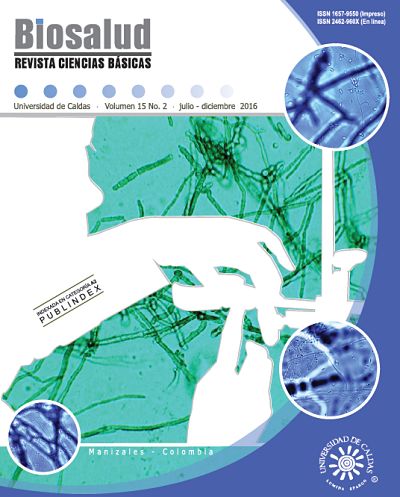Authors
Abstract
Introduction: Myotonic dystrophy (MD) is a rare genetic disease. It is produced by an increased repetition of the CTG triplet in the DMPK gene (locus 19q13.32), or by increasing repetitions of CCTG in the ZNF9 gene (locus 3q21.3). Its phenotype is variable, and its key features are progressive muscle weakness and myotonia. The aim of this publication is to report a Colombian case of myotonic dystrophy type 1 with molecular diagnosis and to contribute to the construction of local epidemiological data on this pathology. Also, to provide information to general practitioners, pediatricians, internists, physiatrists, neurologists, and health personnel who may have contact with patients with progressive muscle weakness, scenario in which myotonic dystrophy is a diagnostic possibility to be considered. Case description: Thirty-seven year old male with a history of poor neonatal suction, delay in developmental milestones, intellectual disability and, in adolescence, the onset of progressive generalized weakness, myotonia and dysphagia. Southern blot and PCR of DMPK gene showed one expanded allele in a range between 1100-1700 repetitions of the CGT triplet and one normal allele, confirming the diagnosis of myotonic dystrophy type 1. Conclusion: The patient reported here presented a phenotype suggestive of myotonic dystrophy type 1; the diagnosis was confirmed by molecular testing. This result made it possible to offer a proper genetic counseling and provide information about the disease.
References
2. Cassidy S, Allanson J. Management of Genetic Syndromes. 2nd Edition. New Jersey, John Wiley & Sons, Inc; 2005.
3. Höweler CJ, Busch HF, Geraedts JP, Niermeijer MF, Staal A. Anticipation in myotonic dystrophy: fact or fiction? Brain 1989; 112 (Pt 3):779–97.
4. Prior TW. Technical standards and guidelines for myotonic dystrophy type 1 testing. Genet Med 2009; 19; 11(7):552–5.
5. Savić Pavićević D, Miladinović J, Brkušanin M, Šviković S, Djurica S, Brajušković G, et al. Molecular Genetics and Genetic Testing in Myotonic Dystrophy Type 1. Biomed Res Int 2013; 2013:1–13.
6. Mahadevan M, Tsilfidis C, Sabourin L, Shutler G, Amemiya C, Jansen G, et al. Myotonic dystrophy mutation: an unstable CTG repeat in the 3’ untranslated region of the gene. Science 1992; 255(5049):1253–5.
7. GeneReviews® [Internet]. Disponible en: https://www.ncbi.nlm.nih.gov/books/NBK1165. Consultado Mayo de 2016
8. Harley HG, Brook JD, Rundle SA, Crow S, Reardon W, Buckler AJ, et al. Expansion of an unstable DNA region and phenotypic variation in myotonic dystrophy. Nature 1992; 355(6360):545–6.
9. Online Mendelian Inheritance in Man, OMIM® [Internet]. Disponible en: http://omim.org/. Consultado Mayo de 2016
10. Botta A, Rinaldi F, Catalli C, Vergani L, Bonifazi E, Romeo V, et al. The CTG repeat expansion size correlates with the splicing defects observed in muscles from myotonic dystrophy type 1 patients. J Med Genet 2008; 45(10):639–46.
11. Usdin K. The biological effects of simple tandem repeats: Lessons from the repeat expansion diseases. Genome Res 2008; 18(7):1011–9.
12. Klesert TR, Cho DH, Clark JI, Maylie J, Adelman J, Snider L, et al. Mice deficient in Six5 develop cataracts: implications for myotonic dystrophy. Nat Genet 2000; 25(1):105–9.
13. Frisch R, Singleton KR, Moses PA, González IL, Carango P, Marks HG, et al. Effect of triplet repeat expansion on chromatin structure and expression of DMPK and neighboring genes, SIX5 and DMWD, in myotonic dystrophy. Mol Genet Metab 2001; 74(1-2):281–91.
14. Chahine M, George AL. Myotonic dystrophy kinase modulates skeletal muscle but not cardiac voltagegated sodium channels. FEBS Lett 1997; 412(3):621–4.
15. Tishkoff DX, Filosi N, Gaida GM, Kolodner RD. A novel mutation avoidance mechanism dependent on S. cerevisiae RAD27 is distinct from DNA mismatch repair. Cell 1997; 88(2):253–63.
16. Mankodi A, Urbinati CR, Yuan QP, Moxley RT, Sansone V, Krym M, et al. Muscleblind localizes to nuclear foci of aberrant RNA in myotonic dystrophy types 1 and 2. Hum Mol Genet 2001; 10(19):2165–70.
17. Miller JW, Urbinati CR, Teng-Umnuay P, Stenberg MG, Byrne BJ, Thornton CA, et al. Recruitment of human muscleblind proteins to (CUG)(n) expansions associated with myotonic dystrophy. EMBO J 2000; 19(17):4439–48.
18. Kanadia RN, Johnstone KA, Mankodi A, Lungu C, Thornton CA, Esson D, et al. A muscleblind knockout model for myotonic dystrophy. Science 2003; 302(5652):1978–80.
19. Llamusi B, Artero R. Molecular Effects of the CTG Repeats in Mutant Dystrophia Myotonica Protein Kinase Gene. Curr Genomics 2008; 9(8):509–16.
20. Timchenko NA, Cai ZJ, Welm AL, Reddy S, Ashizawa T, Timchenko LT. RNA CUG repeats sequester CUGBP1 and alter protein levels and activity of CUGBP1. J Biol Chem 2001; 276(11):7820–6.
21. Ho TH, Bundman D, Armstrong DL, Cooper TA. Transgenic mice expressing CUG-BP1 reproduce splicing mis-regulation observed in myotonic dystrophy. Hum Mol Genet 2005; 14(11):1539–47.
22. Harley HG, Rundle SA, MacMillan JC, Myring J, Brook JD, Crow S, et al. Size of the unstable CTG repeat sequence in relation to phenotype and parental transmission in myotonic dystrophy. Am J Hum Genet 1993; 52(6):1164–74.
23. Hunter A, Tsilfidis C, Mettler G, Jacob P, Mahadevan M, Surh L, et al. The correlation of age of onset with CTG trinucleotide repeat amplification in myotonic dystrophy. J Med Genet 1992; 29(11):774–9.
24. Redman JB, Fenwick RG, Fu YH, Pizzuti A, Caskey CT. Relationship between parental trinucleotide GCT repeat length and severity of myotonic dystrophy in offspring. JAMA 1993; 269(15):1960–5.

 pdf (Español (España))
pdf (Español (España))
 FLIP
FLIP


















